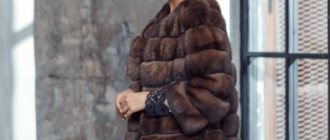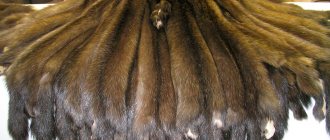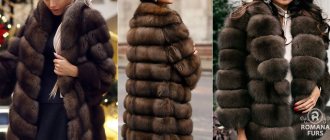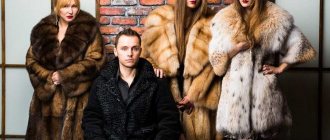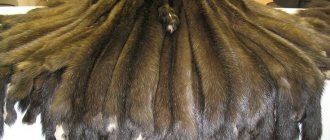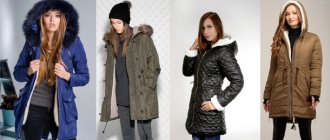Colors and shades of sable fur: the most valuable sable ridge
The natural color, density and length of the pile directly depend on the geography and habitat of the commercial sable. The color and shades of sable fur vary from light sand, fawn to dark brown, brown and almost black. There are 7 primary colors with gradation from the darkest with number 1 to the lightest with number 7.
The cost of sable fur is also affected by “gray hair” or “silvery”: the more gray hairs found on the skin, the more valuable the fur. There are 5 degrees of “silver”. “Deaf” is a sable with zero degree of gray hair. If the skin has 10% gray hairs, then it belongs to the first degree of silvery, 20% to the second, and so on until the fifth. Only an experienced expert will be able to reliably determine the shade of sable color and its price category. There are so-called ridges depending on the mining area:
- Barguzinsky is found in the Irkutsk region, Chita, Buryatia and in the forests of the Baikal region. Medium skin size, the darkest color of all ridges, very thick and silky hair. A fur coat made of Barguzin sable of a dark brown color, silvered with gray hairs, can become an elite acquisition and a good investment, since it will delight its owner with an impeccable appearance for at least ten seasons.
- The Yenisei sable is inferior to the Barguzin sable in color (color varies from beige to caramel) and silkiness of fur. Large and medium size skins, lush pile.
- The Kamchatka is distinguished by its large pelt size and a large amount of gray hair, but its fur is a little coarse.
- Amur sable is characterized by medium and small sizes, less dense and silky hair.
- The Minusinsk Ridge is distinguished by an impressive number of silvery hairs.
- Yakut sable, despite the good quality and thickness of the fur, produces small skins. Rarely found on sale due to the difficulty of setting the product. Everyone has a rough idea of how many sable skins are needed for a fur coat.
The most valuable ridge in terms of richness and luxury of color, silkiness and silveriness is Barguzin. Fashionable tinting, adding depth, smooth transitions and refined shades, undoubtedly improves and makes sable fur of the lower color category more attractive. But even high-quality painting can never compare with the natural beauty and brilliance of commercial sable.
Directions of sable fashion
What products are now made from sable? Of course, these are hats and fur coats, but with the increased interest in jackets, jackets and vests, in today's fashion these products are also sewn from sable fur. Plus, sable fur is used to decorate sheepskin coats, hats, dresses, suits and related items - bags, ties, gloves, etc. The way a sable fur coat looked before this time, you won’t see one like it now. Traditional “robes” with an English collar and trapeze do not at all satisfy the demands of fashionistas. When sewing fashion items, new directions are often used - short sleeves, transverse orientation of skins, etc. When oriented transversely, a striped effect appears, which can be increased by inserting strips of suede between the partings. It is also easier to choose skins for transverse placement than in another case, since the skins are different.
What to choose a mink or sable fur coat?
What to choose a mink or sable fur coat?
To decide whose fur is more attractive, which skin looks and wears much better, and which is more profitable, you need to have a good understanding of these representatives of fur-bearing animals.
Mustelids, which include sable and mink, are the most beautiful and common furs. In addition to these two magnificent animals, mustelids include, of course, marten, ermine and wolverine. All these animals, and therefore the furs, are exceptionally attractive and of high quality. But you shouldn’t get into the wilds of fur farming, but just stop at our two representatives.
Sable and mink have the same features. Firstly, their fur is quite long, which makes the coats elegant and warm. Secondly, the undercoat of both representatives is quite lush, which allows them to wear fur coats in the most severe frosts. But these indicators relate more to wild representatives, and if sable is the only way to get it, then it is almost impossible to find wild mink, since all fur coats are made exclusively from domesticated animals.
Here is the first difference between sable and mink. The latter has an amazing variety of breeds, shapes, colors and other differences. This factor has made mink the world leader in the fur business.
The difference between the furs of mink breeds is the same as between dog breeds. That is, by nature they are dogs, but in reality they are completely different. The same goes for mink - colors range from the standard dark brown, to blue, and the rarest - white. The underfur can be very thick, like that of a Russian mink, or absent altogether.
Sable fur is more expensive, which is explained by the magnificent appearance, high quality and rarity of the animal. Sable is used in its raw form, because any interference with such a valuable item is blasphemy. But they do absolutely any kind of thing with a mink - they cut it, dye it, pluck it, and much more.
Sable is an indicator of high status, just like expensive mink. But the presence of more affordable mink fur coats in the assortment creates its versatility, which is more acceptable on the world market.
A combination of sable and mink is an excellent choice; such products cost significantly less than pure sable, but surpass mink in status and beauty. Mink becomes the main fur, and sable is used for finishing and decoration.
So it’s difficult to choose; sable looks much more impressive, while mink is more affordable.
greatgrace.ru
Animal rights activists against Lagerfeld
Since 36 sable skins were used to make the fur coat, environmentalists were outraged by Lagerfeld's activities. They renamed the show "haute couture" (high fashion) to "haute horreur" (high horror). The designer was dubbed an undertaker, his actions were recognized as pathetic and shameful.
Against the backdrop of the display of a unique fur product in America and Europe, the fashion industry experienced a movement called “fur free”, which opposed the use of natural fur in clothing. Luxury brands such as Ralph Lauren, Stella McCartney, Armani, Calvin Klein and others have united in associations, and some large department stores in the world have generally introduced a ban on the sale of fur products.
You found out which fur coat is the most expensive. For some it is a work of art, and for others it is a funeral procession. For many years, animal rights activists from PETA have been fighting the fashion house Fendi, trying to pacify Lagerfeld, who loves to make clothes from leather and fur. When it was mentioned in the media that the world's most expensive fur coat would be shown at Paris Fashion Week, activists planned to disrupt the event and reported it.
In response, Karl said that the refusal to use natural fur when sewing clothes would entail a significant increase in the unemployment rate, since people working in production would have to quit their jobs.
But, despite the conflicts that arise, Karl Lagerfeld is clearly considered one of the most brilliant people in the fashion world. You can watch a video showing the described fur product below:
The most expensive fur coat in the world and its features
The idea of creating the most expensive fur coat in the world belongs to the famous designer, Karl Lagerfeld. This unique fur product is made of sable fur. In total, 36 sable skins were spent on the fur coat. The product is valued at one million euros.
The most expensive fur coat in the world is so expensive not only because a large number of animal skins were used to sew it. The manufacturing feature also consisted of special technology. A special metallized coating was applied to the fur, giving the surface a special shine. That is why the most expensive fur coat in the world, the price of which is incredible for the average person, is called “Moonlight on water”. She delighted fashion critics.
Dyeing sable fur
Painting and tinting of fur is rarely used; very often they try to preserve the natural beauty. If this is done, it is for the sake of preserving color transitions. Bleaching is not always performed, but only the brightest skins are chosen for it from the very beginning. During the bleaching process, they again try not to affect the guard hairs, maintaining naturalness, and lighten only the matte gray underfur. When tinting fur, a better selection of skins is achieved in the product. More valuable dark tones are not always obtained. The best tinting of sable is possible only with very high-tech dressings. By the way, when you can see how well the tinting is done in a product, this will be one of the signs of the high level of the product. But it happens that tinting is not done deliberately in order to give naturalness. But it is performed very often. Today's Italian and French fur products are made with very perfect tinting, in which you can get the long-awaited dark color of the Barguzin sable
, while maintaining silkiness, softness and gray hair in the fur. It is not yet possible to achieve artificial gray hair.

